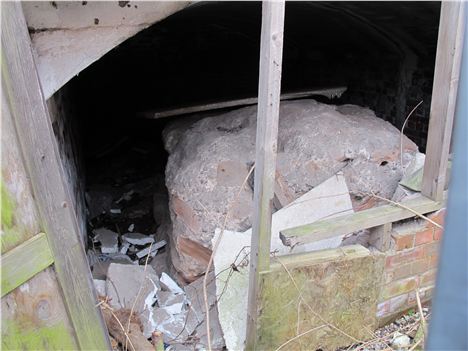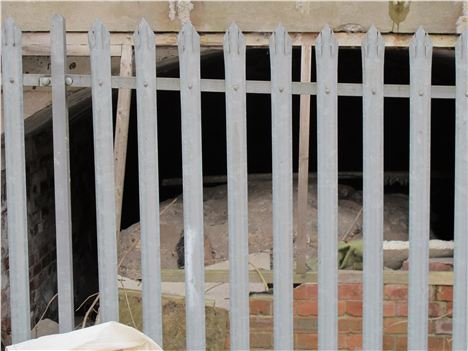ROMAN MANCHESTER: THE TALK
To help raise funds for Castlefield’s Roman Gardens project, which has already attracted almost £30,000 from the successful crowdfunding campaign (including £500 from Confidential), archaeologist and an expert on Manchester’s Roman heritage, Norman Redhead, will be giving a talk on Thursday 21 May in the Merchant’s Room above Albert’s Shed in Castlefield in Manchester city centre.
He will focus particularly on the story of Roman and later developments on the site of the Roman Gardens, including the reconstruction of the Roman fort and settlement. There will also be an opportunity for guests to ask questions.
Carol Middleton, Chair of the Castlefield Forum said: “We’re delighted that Norman Redhead is able to support our crowdfunding campaign for the Roman Gardens project by sharing his vast knowledge of Manchester’s Roman History. His talks are always fascinating and very popular and we expect this one to be no different.
“The Roman Gardens project links the 2,000-year-old Roman heritage of the site with the modern day city. If planning is approved, the Forum will work with Greater Manchester Archaeological Advisory Service to hold a series of community digs to uncover more about the Roman heritage of the Gardens.”
The 60 minute talk will start at 7pm. A minimum donation of £5 per person is requested. Places are limited and will be allocated on a first come, first served basis on the evening. The event is expected to be popular so an early arrival is recommended to avoid disappointment.
For more information on the Roman Gardens project and to pledge visit http://www.spacehive.com/romangardens

Manchester Confidential originally published the article about Roman Manchester and its last true remains below in February 2012 but has been updated.
THERE'S a poor neglected lump of Castlefield masonry fenced in under a railway arch that is very old.
In fact it’s as old as it gets in Manchester. It dates from around 200 AD and is thus around a thousand years older than any other masonry in the city.

This piece is used to taking the hits. It's survived the abandonment of the fort when the Romans left, the pillaging of the site for building materials for centuries, and it survived the Industrial Revolution. It’s a real survivor too, Roman, and one of six scheduled ancient monuments in Manchester. Not that you'd guess. This reminder of our distant past is covered in detritus, walled in, fenced off, and utterly neglected.
An Industrial Revolution that ran two canals through the old Roman fort site, three railway systems and covered the area with houses, workshops and factories.
In particular it survived the construction of the viaduct that carries the Manchester South Junction and Altrincham Railway over where the fragment lies.
Now it lies lost and inaccessible closed off from the curious visitor on a private site in Castlefield. Recently this had its gates opened as electrification of the rail lines takes place.
Confidential sneaked into what is still a private area to snap the Roman relic. Call it an act of benign trepass.
Manchester starts with the Romans.
No record has been found of buildings related to the Setantii branch of the local Brigantes tribe that occupied this area so it must have been the cohorts of XXth Valeria Victrix legion, under General Agricola, who spotted Manchester's potential in 79 AD.
In particular they recognised the strategic value of the rounded bluff over the confluence of the Rivers Irwell and Medlock and named it Mamucium or 'breast shaped hill'.
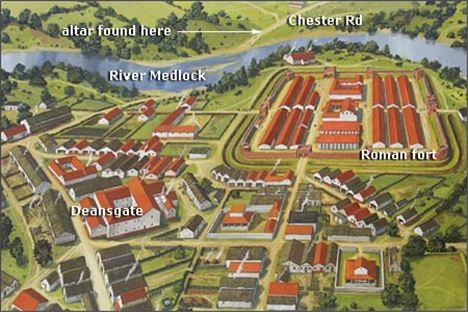 Our fragment of wall lies on the left hand, eastern wall, of the fort in this conjectural image
Our fragment of wall lies on the left hand, eastern wall, of the fort in this conjectural image
The Romans stayed for over three centuries. Their fort was garrisoned, at its peak, by an 800 strong mixed force of infantry and cavalry. This was an auxiliary regiment, not native Romans, but recruits or conscripts from the other provinces.
Primarily the place was military in character but as often happened outside Roman forts a civilian settlement grew which accommodated the unofficial wives of the soldiers and attracted artisans and craftsmen, who set up furnaces and workshops.
During excavations in the seventies a Christian 'magic square' dating from 175 AD was found. This coded inscription spells the word Paternoster, the opening words of the Lord's Prayer in Latin. It’s the oldest evidence of Christianity in the country.
The Romans chose their site well and Manchester became a transport hub.
Seven roads met at the fort, more than at any other site in the North. Future movements of people and resources would, for convenience sake, move along these routes and come directly through Manchester.
Many of the main routes into the city still follow Roman lines – the roads met where Beetham Tower now stands which explains why it’s always dead ahead on so many key arteries into the city.
Roman authority officially abandoned Britain in 410 AD and eventually the Saxons moved in. The Latin word 'castrum' meaning fort was twisted into the 'chester' element of the name.
The Saxons moved the settlement northwords. They needed a more easily defensible place so they chose the area around the present-day Cathedral, on the sandstone lump above the confluence of the River Irk and River Irwell, where Chetham’s School of Music and Library now sit.
The Saxons also feared the supernatural.
The old Roman fortresses and settlements looked like the work of giants to them, impossibly clever and complex.
One of the great poems of English and one of the language's earliest is The Ruin reproduced below, which reflects what the Saxons thought of the remnants of Imperial Rome’s power and authority they kept encountering.
That fragment of Mamucium that remains under the railway arch has potency.
The reconstruction of Roman fort gates, ditches and walls elsewhere in Castlefield are great fun and valuable in showing off our history, but they are reconstructions. (The recent display boards, by the way, giving a very clear description of Roman Manchester, are very welcome.)
So despite its apparent modesty, this scruffy, hoary old fragment is the real deal, laid down by Roman era hands.
It gives us that link with the ancient past of Manchester.
It marks the alpha node of this famous city.
And it does this silently and alone, a fort wall imprisoned and hidden behind it's own cheap, recent fortifications.
You can follow Jonathan Schofield on Twitter here @JonathSchofield
The Ruin (ninth century Anglo-Saxon poetry fragment)
This masonry is wondrous; fates broke it
courtyard pavements were smashed; the work of giants is decaying.
Roofs are fallen, ruinous towers,
the frosty gate with frost on cement is ravaged,
chipped roofs are torn, fallen,
undermined by old age. The grasp of the earth possesses
the mighty builders, perished and fallen,
the hard grasp of earth, until a hundred generations
of people have departed. Often this wall,
lichen-grey and stained with red, experienced one reign after another,
remained standing under storms; the high wide gate has collapsed.
Still the masonry endures in winds cut down
persisted on__________________
fiercely sharpened________ _________
______________ she shone_________
_____________g skill ancient work_________
_____________g of crusts of mud turned away
spirit mo________yne put together keen-counselled
a quick design in rings, a most intelligent one bound
the wall with wire brace wondrously together.
Bright were the castle buildings, many the bathing-halls,
high the abundance of gables, great the noise of the multitude,
many a meadhall full of festivity,
until Fate the mighty changed that.
Far and wide the slain perished, days of pestilence came,
death took all the brave men away;
their places of war became deserted places,
the city decayed. The rebuilders perished,
the armies to earth. And so these buildings grow desolate,
and this red-curved roof parts from its tiles
of the ceiling-vault. The ruin has fallen to the ground
broken into mounds, where at one time many a warrior,
joyous and ornamented with gold-bright splendour,
proud and flushed with wine shone in war-trappings;
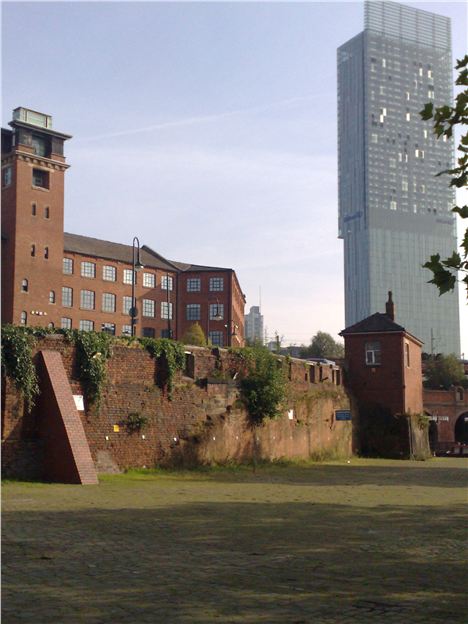 The sandstone face here stands over the River Medlock (now flowing in a tunnel under the adjacent Bridgewater Canal) the Roman Fort lay above it
The sandstone face here stands over the River Medlock (now flowing in a tunnel under the adjacent Bridgewater Canal) the Roman Fort lay above it
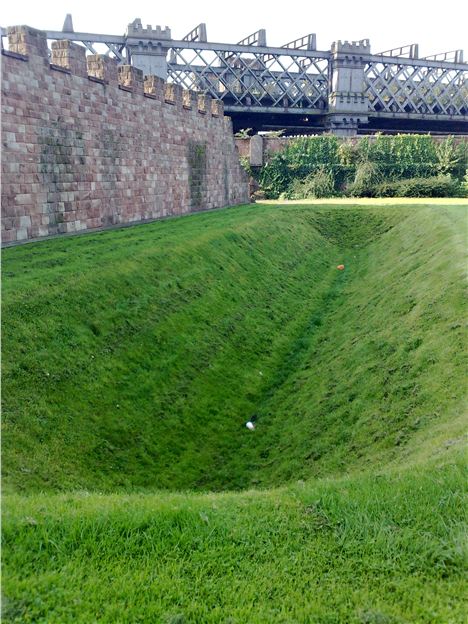 Part of the reconstructed west wall and ditch of Mamucium
Part of the reconstructed west wall and ditch of Mamucium









